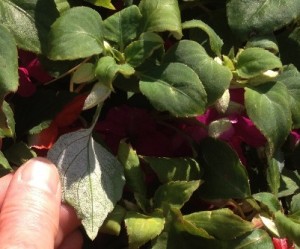Have you got impatients in your Minneapolis area garden? You may want to inspect them for signs of disease. Impatiens downy mildew – which results in severe defoliation and blossom drop – first showed up on impatiens in 2011 in Minnesota and on both coasts. It is caused by the pathogen Plasmopara obducens and is often referred to as a water mold. Impatiens downy mildew affects all hybrids and varieties of Impatiens Wallerianna. However, New Guinea Impatiens are considered to be very tolerant of this disease. Downy mildew is introduced when cuttings in a greenhouse are infected. Impatiens grown from seed are not infected.
The disease typically affects a few leaves to start, as they appear light yellow and speckled yellow and green. The leaf edges start to curl downward and appear as they are wilted. The underside of the leaves appears to have a fluffy downy-like white growth. First the blossoms drop off, than the leaves fall off, and finally as the disease progresses the plant lays flat on the ground.

Some preventative measures that can help prevent downy mildew are: avoid planting impatiens in any infected beds, use clean pots for container plantings, and don’t compost diseased plants – put them in the garbage. It likely that infection from one year to the next will occur since this pathogen can survive over the winter in infected beds. It produces sporangia on the lower surface of the infected leaves that can become airborne and travel long distances on moist air, causing it to spread from plant to plant. It thrives in temperatures 63-73°F in moist, cold conditions. In order to for sporangia to form, the leaves have to be wet for four hours, so checking the amount and time that a irrigation system runs is a good idea.
If you find down mildew on your impatiens, it does open some new doors for creative planting with some alternatives. Some choices to use in beds that have been infected with impatiens downy mildew are coleus, caladium, begonia, and New Guinea impatiens.
If you’ve got garden beds that have been infected with Impatiens downy mildew disease, we’d be happy to suggest some unique replacement plantings which will complement your current landscape design. Or if you think this is good time for a major overhaul, we can discuss bringing your visions to reality.
